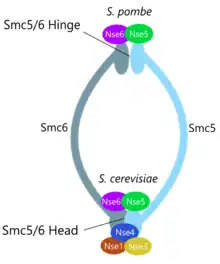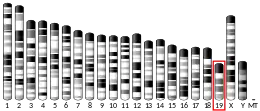SMC5
Structural maintenance of chromosomes protein 5 is a protein encoded by the SMC5 gene in human.[5][6]
The structural maintenance of chromosomes' complex underlying mechanisms involved in the dynamics of chromatin dynamics is unknown, and new discoveries are shedding light on the various functions.[7] The SMC complex mediates long-distance interactions that enable higher-order folding of chromatin in interphase. The SMC complex has an ATPase activity, a conserved kleisin, as well as regulatory subunits.[7] SMC protein complexes are involved in DNA repair, transcriptional pathways, regulation of chromosome segregation, and immunity in Arabidopsis. In eukaryotes the structural maintenance chromosomes consists of cohesin (SMC1 AND SMC3), condensin (SMC2 and SMC4), and SMC5/6 complexes.
Structure
The Smc5/6 complex was discovered in fission yeast. RAD18 (SMC6), the DNA damage gene in fission yeast, also encodes an SMC-like protein and forms a heterodimeric complex with Spr18 (SMC5) protein.[8][9] In yeast, SMC5/6 complex has sub-units which consists of SMC5, SMC6 and six nonstructural maintenance of chromosomes (NSE) proteins. Nse1-Nse3-Nse4 subunits bridge the Smc5 head Smc6 and allow the binding of DNA.[10][11][12]
It is involved in the Alternative lengthening of telomeres cancer mechanism.[13][14]
Nse subunits
Nse1-Nse3-Nse4 subunits bridge the heads of the Smc5 and Smc6 proteins and allow the complex to bind DNA. Nse5 and Nse6 form a sub-complex which localizes to the head of the SMC5/6 complex in the budding yeast Saccharomyces cerevisiae, and to the hinges of the SMC5/6 complex in the fission yeast Schizosaccharomyces pombe. The Nse5/6 sub-complex is required for the replication of S. cerevisiae, but has not been characterized as essential in S. pombe. Orthologous proteins to Nse5-Nse6 exist in other eukaryotes, namely ASAP1-SNI1 in Arabidopsis thaliana and SLF1-SLF2 in humans, which are believed have similar function to their Nse counterparts. The localization of SLF1 and SLF2 on the human SMC5/6 complex is unknown.[15][16]

Localization in different organisms
The Smc5/6 complex has localization methods which are not heavily conserved. In humans the complex is localized to viral DNA sequences using SMC5/6 localization factors 1 and 2 (SLF1 and SLF2) which contributes to viral resistance.[17] In the plant A. thaliana, this heterodimer can be localized to double stranded breaks for homologous recombination using the SWI3B complex of the SWI/SNF pathway.[18] Once localized to the DNA, the SCM5/6 complex non-specifically binds to ~20 DNA base pairs[19]
Role in recombination and meiosis
Smc5 and Smc6 proteins form a heterodimeric ring-like structure and, together with other non-SMC elements, form the SMC-5/6 complex. In the worm Caenorhabditis elegans this complex interacts with the HIM-6(BLM) helicase to promote meiotic recombination intermediate processing and chromosome maturation.[20] The SMC-5/6 complex in mouse oocytes is essential for the formation of segregation competent bivalents during meiosis.[21] In humans, a chromosome breakage syndrome characterized by severe lung disease in early childhood is associated with a mutation in a component of the SMC-5/6 complex.[22] Patient's cells display chromosome rearrangements, micronuclei, sensitivity to DNA damage and defective homologous recombination.
References
- GRCh38: Ensembl release 89: ENSG00000198887 - Ensembl, May 2017
- GRCm38: Ensembl release 89: ENSMUSG00000024943 - Ensembl, May 2017
- "Human PubMed Reference:". National Center for Biotechnology Information, U.S. National Library of Medicine.
- "Mouse PubMed Reference:". National Center for Biotechnology Information, U.S. National Library of Medicine.
- Nagase T, Ishikawa K, Miyajima N, Tanaka A, Kotani H, Nomura N, Ohara O (February 1998). "Prediction of the coding sequences of unidentified human genes. IX. The complete sequences of 100 new cDNA clones from brain which can code for large proteins in vitro". DNA Research. 5 (1): 31–9. doi:10.1093/dnares/5.1.31. PMID 9628581.
- "Entrez Gene: SMC5 structural maintenance of chromosomes 5".
- Jeppsson K, Kanno T, Shirahige K, Sjögren C (September 2014). "The maintenance of chromosome structure: positioning and functioning of SMC complexes". Nature Reviews. Molecular Cell Biology. 15 (9): 601–14. doi:10.1038/nrm3857. PMID 25145851. S2CID 23908801.
- Fousteri MI, Lehmann AR (April 2000). "A novel SMC protein complex in Schizosaccharomyces pombe contains the Rad18 DNA repair protein". The EMBO Journal. 19 (7): 1691–702. doi:10.1093/emboj/19.7.1691. PMC 310237. PMID 10747036.
- Lehmann AR, Walicka M, Griffiths DJ, Murray JM, Watts FZ, McCready S, Carr AM (December 1995). "The rad18 gene of Schizosaccharomyces pombe defines a new subgroup of the SMC superfamily involved in DNA repair". Molecular and Cellular Biology. 15 (12): 7067–80. doi:10.1128/mcb.15.12.7067. PMC 230962. PMID 8524274.
- Palecek J, Vidot S, Feng M, Doherty AJ, Lehmann AR (December 2006). "The Smc5-Smc6 DNA repair complex: bridging of the Smc5-Smc6 heads by the KLEISIN, Nse4, and non-Kleisin subunits". The Journal of Biological Chemistry. 281 (48): 36952–36959. doi:10.1074/jbc.M608004200. PMID 17005570.
- Zabrady K, Adamus M, Vondrova L, Liao C, Skoupilova H, Novakova M, Jurcisinova L, Alt A, Oliver AW, Lehmann AR, Palecek JJ (February 2016). "Chromatin association of the SMC5/6 complex is dependent on binding of its NSE3 subunit to DNA". Nucleic Acids Research. 44 (3): 1064–1079. doi:10.1093/nar/gkv1021. PMC 4756808. PMID 26446992.
- Vondrova L, Kolesar P, Adamus M, Nociar M, Oliver AW, Palecek JJ (June 2020). "A role of the Nse4 kleisin and Nse1/Nse3 KITE subunits in the ATPase cycle of SMC5/6". Scientific Reports. 10 (1): 9694. Bibcode:2020NatSR..10.9694V. doi:10.1038/s41598-020-66647-w. PMC 7297730. PMID 32546830.
- Potts PR, Yu H (July 2007). "The SMC5/6 complex maintains telomere length in ALT cancer cells through SUMOylation of telomere-binding proteins". Nature Structural & Molecular Biology. 14 (7): 581–90. doi:10.1038/nsmb1259. PMID 17589526. S2CID 7915836.
- Grange LJ, Reynolds JJ, Ullah F, Isidor B, Shearer RF, Latypova X, et al. (November 2022). "Pathogenic variants in SLF2 and SMC5 cause segmented chromosomes and mosaic variegated hyperploidy". Nature Communications. 13 (1): 6664. doi:10.1038/s41467-022-34349-8. PMC 9636423. PMID 36333305.
- Yan, Shunping; Wang, Wei; Marqués, Jorge; Mohan, Rajinikanth; Saleh, Abdelaty; Durrant, Wendy E.; Song, Junqi; Dong, Xinnian (2013-11-21). "Salicylic Acid Activates DNA Damage Responses to Potentiate Plant Immunity". Molecular Cell. 52 (4): 602–610. doi:10.1016/j.molcel.2013.09.019. ISSN 1097-2765. PMC 3863363.
- Diaz, Mariana; Pecinka, Ales (2018-01-12). "Scaffolding for Repair: Understanding Molecular Functions of the SMC5/6 Complex". Genes. 9 (1): 36. doi:10.3390/genes9010036. ISSN 2073-4425. PMC 5793187.
- Oravcová, Martina; Nie, Minghua; Zilio, Nicola; Maeda, Shintaro; Jami-Alahmadi, Yasaman; Lazzerini-Denchi, Eros; Wohlschlegel, James A; Ulrich, Helle D; Otomo, Takanori; Boddy, Michael N (2022-11-14). Chiolo, Irene E; Tyler, Jessica K (eds.). "The Nse5/6-like SIMC1-SLF2 complex localizes SMC5/6 to viral replication centers". eLife. 11: e79676. doi:10.7554/eLife.79676. ISSN 2050-084X. PMC 9708086. PMID 36373674.
- Jiang, Jieming; Mao, Ning; Hu, Huan; Tang, Jiahang; Han, Danlu; Liu, Song; Wu, Qian; Liu, Yiyang; Peng, Changlian; Lai, Jianbin; Yan, Changwei (July 8, 2019). "A SWI/SNF subunit regulates chromosomal dissociation of structural maintenance complex 5 during DNA repair in plant cells". Proceedings of the National Academy of Sciences. 116 (30): 15288–15296. doi:10.1073/pnas.1900308116. ISSN 0027-8424. PMC 6660752. PMID 31285327.
- Yu, You; Li, Shibai; Ser, Zheng; Kuang, Huihui; Than, Thane; Guan, Danying; Zhao, Xiaolan; Patel, Dinshaw J. (2022-06-07). "Cryo-EM structure of DNA-bound Smc5/6 reveals DNA clamping enabled by multi-subunit conformational changes". Proceedings of the National Academy of Sciences. 119 (23): e2202799119. doi:10.1073/pnas.2202799119. ISSN 0027-8424. PMC 9191643. PMID 35648833.
- Hong Y, Sonneville R, Agostinho A, Meier B, Wang B, Blow JJ, Gartner A (March 2016). "The SMC-5/6 Complex and the HIM-6 (BLM) Helicase Synergistically Promote Meiotic Recombination Intermediate Processing and Chromosome Maturation during Caenorhabditis elegans Meiosis". PLOS Genetics. 12 (3): e1005872. doi:10.1371/journal.pgen.1005872. PMC 4807058. PMID 27010650.
- Hwang G, Sun F, O'Brien M, Eppig JJ, Handel MA, Jordan PW (May 2017). "SMC5/6 is required for the formation of segregation-competent bivalent chromosomes during meiosis I in mouse oocytes". Development. 144 (9): 1648–1660. doi:10.1242/dev.145607. PMC 5450844. PMID 28302748.
- van der Crabben SN, Hennus MP, McGregor GA, Ritter DI, Nagamani SC, Wells OS, et al. (August 2016). "Destabilized SMC5/6 complex leads to chromosome breakage syndrome with severe lung disease". The Journal of Clinical Investigation. 126 (8): 2881–92. doi:10.1172/JCI82890. PMC 4966312. PMID 27427983.
Further reading
- Nakajima D, Okazaki N, Yamakawa H, Kikuno R, Ohara O, Nagase T (June 2002). "Construction of expression-ready cDNA clones for KIAA genes: manual curation of 330 KIAA cDNA clones". DNA Research. 9 (3): 99–106. CiteSeerX 10.1.1.500.923. doi:10.1093/dnares/9.3.99. PMID 12168954.
- Taylor EM, Moghraby JS, Lees JH, Smit B, Moens PB, Lehmann AR (June 2001). "Characterization of a novel human SMC heterodimer homologous to the Schizosaccharomyces pombe Rad18/Spr18 complex". Molecular Biology of the Cell. 12 (6): 1583–94. doi:10.1091/mbc.12.6.1583. PMC 37326. PMID 11408570.
- Potts PR, Yu H (August 2005). "Human MMS21/NSE2 is a SUMO ligase required for DNA repair". Molecular and Cellular Biology. 25 (16): 7021–32. doi:10.1128/MCB.25.16.7021-7032.2005. PMC 1190242. PMID 16055714.
- Potts PR, Porteus MH, Yu H (July 2006). "Human SMC5/6 complex promotes sister chromatid homologous recombination by recruiting the SMC1/3 cohesin complex to double-strand breaks". The EMBO Journal. 25 (14): 3377–88. doi:10.1038/sj.emboj.7601218. PMC 1523187. PMID 16810316.



